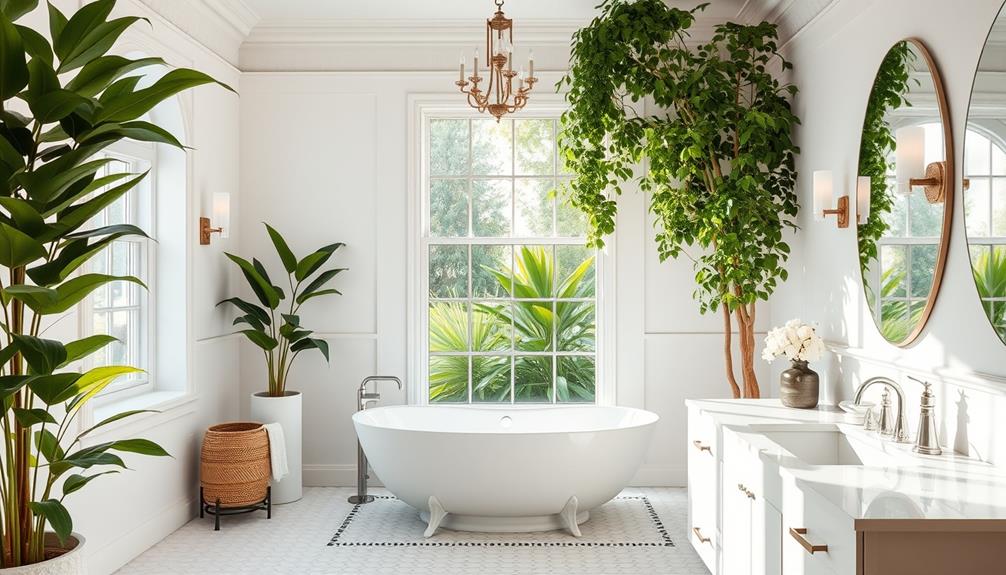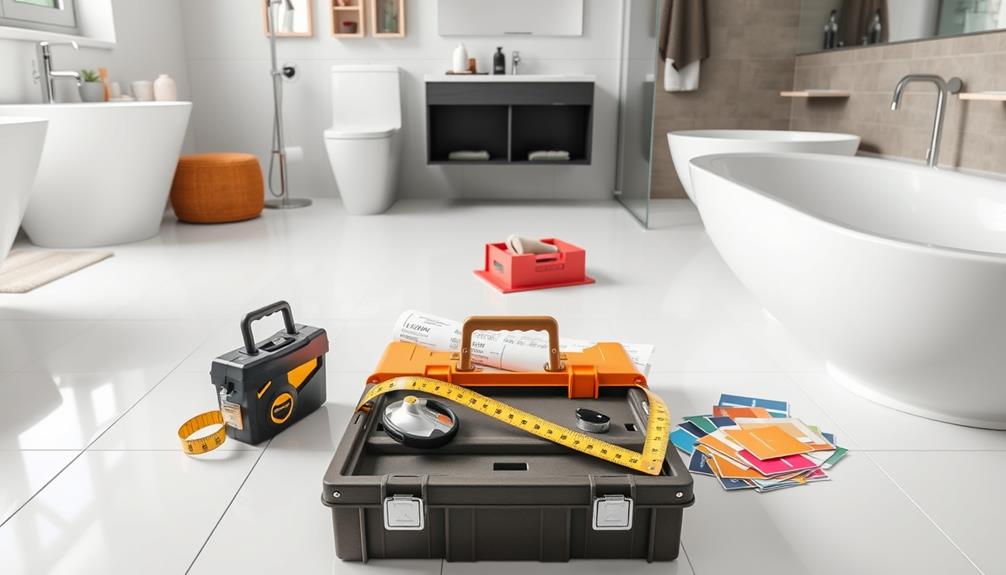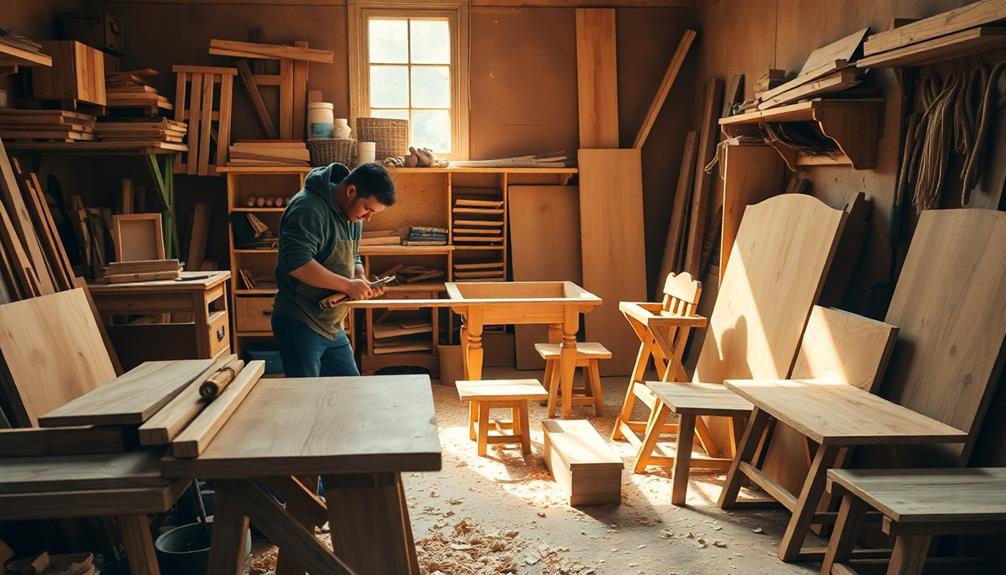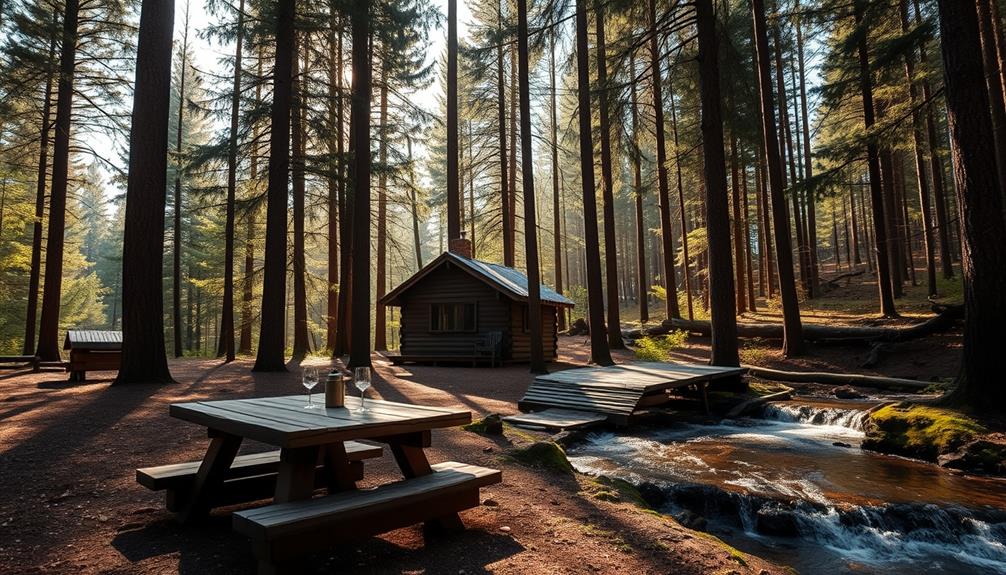For a successful bathroom renovation, it is crucial to begin by establishing your budget and desired level of remodeling. Develop a comprehensive floor plan that includes precise measurements of the current layout and plumbing considerations. Decide whether you will take on the project yourself or hire a professional based on your capabilities. Don’t overlook the importance of verifying local permit requirements. Safely remove old fixtures and install new ones that meet code regulations. Lastly, choose finishing touches that reflect your style, such as accessories and decor. By following a well-thought-out plan, you can confidently turn your bathroom into a personal sanctuary with additional insights. Incorporating energy-efficient fixtures and sustainable materials during your renovation can help reduce your environmental footprint and lower utility expenses. Optimize storage space and functionality by opting for smart storage solutions and versatile furniture pieces. These bathroom remodeling guidelines can assist you in creating a trendy and practical bathroom that suits your preferences.
Key Takeaways
- Determine your remodeling level and budget to avoid overspending and prioritize necessary upgrades.
- Develop a detailed floor plan, assessing existing layouts and plumbing locations for optimal fixture placement.
- Explore financing options, such as home equity loans, to support your remodeling budget effectively.
- Obtain necessary permits early to ensure compliance and avoid complications during the renovation process.
- Select key fixtures and finishing touches that enhance both functionality and aesthetic appeal in the bathroom.
Determine Remodeling Level
When you start planning your bathroom remodel, the first thing you need to do is determine the remodeling level that suits your needs and budget. Your options range from a simple bathroom renovation focused on cosmetic updates to a complete redesign that alters the room's structure and layout.
Understanding your financial goals and setting a budget is vital for this process, as it will help you avoid common financial mistakes such as overspending.
If you're looking for minimal changes, consider a surface remodel. This involves updating fixtures, painting, and changing accessories without significant plumbing changes. It usually costs a few thousand dollars.
On the other hand, a gut and replace remodel maintains the current layout, replacing all fixtures and finishes, and typically costs between $15,000 and $18,000.
If you want to move fixtures around but keep the existing footprint, a layout change remodel might be right for you. Just keep in mind that this often requires additional plumbing and electrical work, which can increase your costs.
Understand Cost Factors
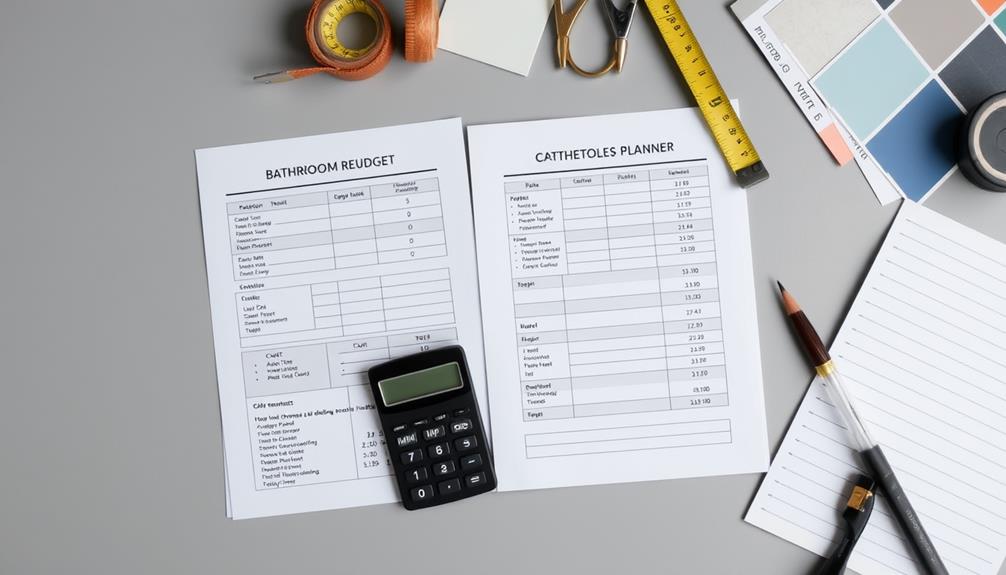
Understanding the cost factors in a bathroom remodel is vital for making informed decisions. Simple surface makeovers can set you back several thousand dollars, while mid-level bathroom remodeling typically ranges from $15,000 to $18,000.
If you're considering extensive renovations that involve notable structural changes or high-end materials, expect costs to exceed $30,000, especially due to plumbing work and subcontracting services. Additionally, incorporating strategies for diversifying investments, such as exploring options like a Gold IRA, can provide financial stability that aids in managing remodeling costs a safe haven during market volatility.
Budgeting is essential in this process. By carefully planning, you can pinpoint areas to splurge or save, which greatly impacts your overall project cost. For instance, you might choose to invest in quality fixtures while opting for more affordable flooring.
Additionally, understanding typical renovation costs can help you avoid overspending. Look into grants or assistance programs for home improvement, as they can alleviate financial strains during a remodel.
If you need more flexibility, consider home equity loans to cover expenses. Balancing your desires with your budget will lead to a successful remodel that meets your needs without breaking the bank. By understanding these cost factors, you'll make certain that your bathroom transformation aligns with your financial goals.
Explore Financing Options
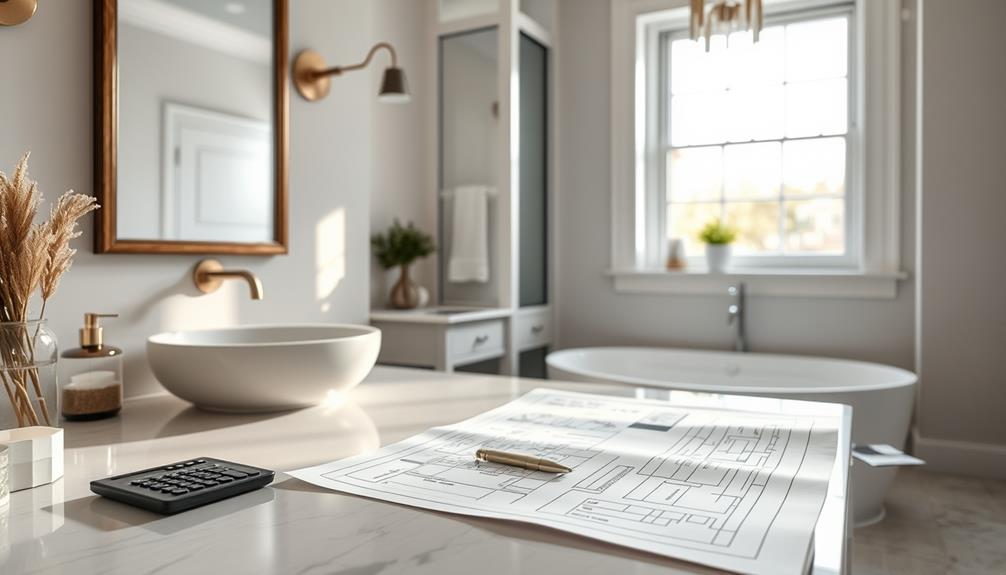
When planning your bathroom remodel, exploring various financing options is essential to stay within budget.
Consider how diversifying your financial portfolio can be just as important as diversifying your retirement investments; just like a Gold IRA can protect against inflation, having a solid financing strategy can safeguard your remodeling project.
Home equity loans can be a great way to leverage your property's value, while smart budgeting strategies can help minimize costs.
Home Equity Loans
Home equity loans can be a smart financing option for your bathroom remodel, allowing you to tap into the equity you've built in your home. These loans let you borrow against that equity, typically offering lower interest rates compared to personal loans or credit cards.
Additionally, many homeowners are exploring alternative investment strategies to fund renovations, including precious metal investments as a way to diversify their financial portfolio. You can usually borrow up to 85% of your home's appraised value minus any outstanding mortgage balance, giving you substantial funds for renovations.
Repayment terms for home equity loans range from 5 to 30 years, letting you spread out those payments over a longer period. This flexibility can make your monthly budget more manageable.
Plus, if you use the funds for home improvements, the interest you pay may be tax-deductible, providing additional financial benefits.
It's essential to shop around and compare different lenders. Fees, interest rates, and loan terms can vary considerably, affecting the overall cost of financing your bathroom remodel.
By doing your homework, you can secure the best deal possible, ensuring your renovation dreams become a reality while keeping your finances in check.
Consider a home equity loan as a viable option to fund your project effectively.
Budgeting Strategies
Creating a solid budget is essential for a successful bathroom remodel. Start by estimating costs for materials, labor, permits, and unexpected expenses, which can range from $15,000 to over $30,000, depending on your project's scope.
To manage your budget effectively, consider various budgeting strategies that align with your bathroom design goals. Additionally, exploring investment options such as a Gold IRA could provide financial security that allows for more flexibility in your renovation plans, as gold investments can act as a hedge against inflation and market volatility diversification of retirement savings through gold investment.
One smart approach is to explore financing options, such as home equity loans. These can provide a low-interest solution, especially for extensive renovations.
Additionally, look for budget-friendly strategies like sourcing materials on sale or choosing alternative plumbing fixtures that maintain quality without breaking the bank.
Don't forget to research potential grants or assistance programs for home improvements in your area. These can help offset renovation expenses considerably.
As you plan, assess the long-term financial impact of your upgrades, ensuring they enhance your home's resale value and appeal.
DIY or Hire a Contractor
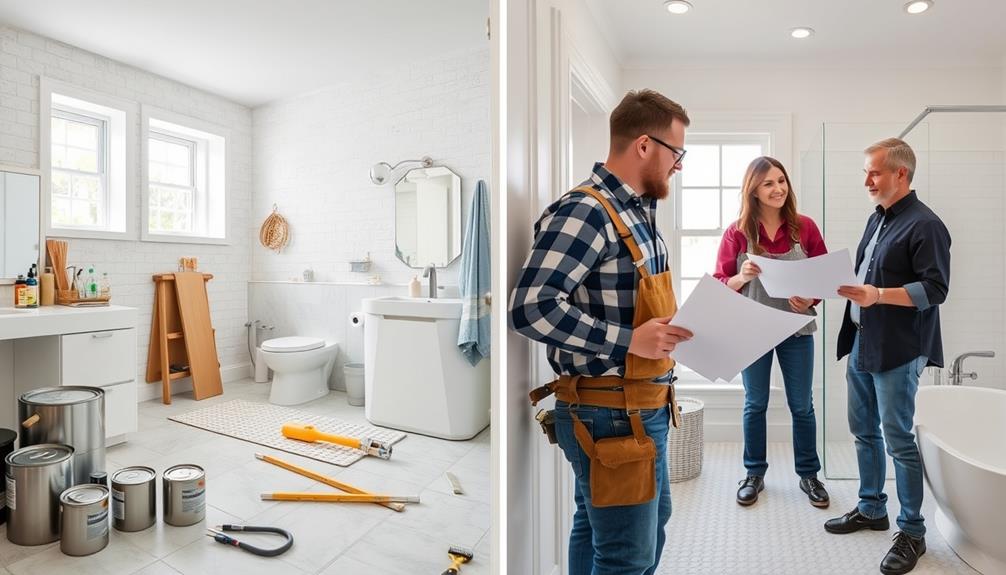
Deciding whether to tackle your bathroom remodel as a DIY project or hire a contractor is an important step that can influence both the outcome and your overall experience.
Start by evaluating your skill level and experience. If you're comfortable with surface alterations, a DIY approach might be manageable. However, for complex tasks like plumbing or electrical work, hiring a contractor is typically necessary.
Additionally, it's vital to reflect on the emotional and psychological support available, especially if the remodel is part of adapting your home for elderly care needs, as this can impact your decision-making process. For example, resources like caregiver support can provide valuable insights.
Examine the scope of your remodel. Major renovations, like tile installation or relocating fixtures, often require a licensed professional to guarantee quality and compliance with local building codes.
While DIY might seem cost-effective, it's important to evaluate the financial implications. Hiring a contractor can increase upfront costs, but it may save you money in the long run by preventing costly mistakes.
Don't forget to research and select qualified contractors. Verify they're properly licensed and insured to avoid issues during the remodel process.
Finally, weigh the benefits of time and convenience. Although DIY saves on labor costs, hiring contractors can greatly reduce project timelines and minimize the stress of managing complicated tasks.
Making the right choice now can lead to a smoother and more successful bathroom remodel.
Develop a Detailed Floor Plan
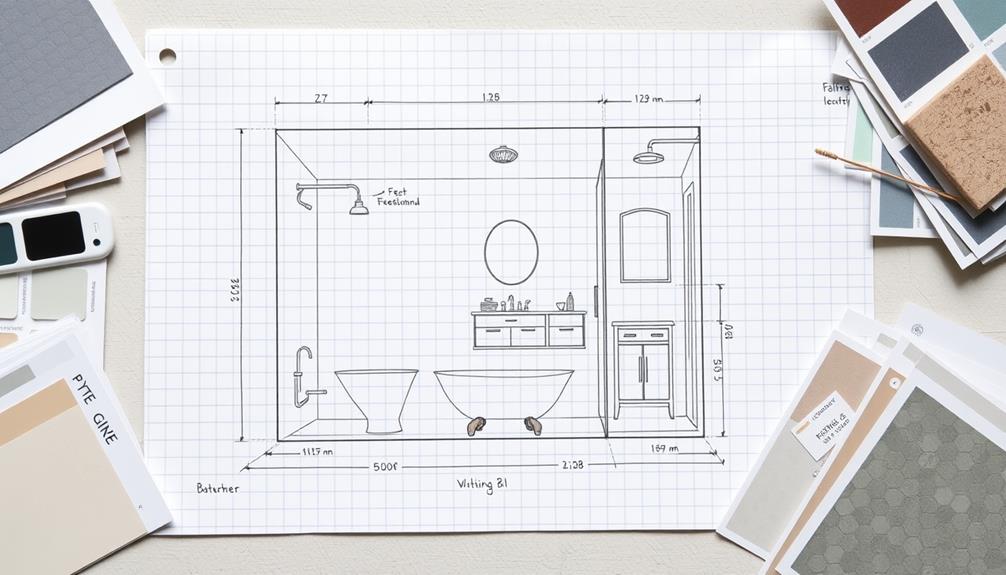
To develop a detailed floor plan for your bathroom remodel, start by evaluating the existing layout.
Consider creating a mood board to visualize your design concepts and guarantee a cohesive look.
Measure the dimensions and take note of plumbing locations, as this will guide your design and help you avoid costly adjustments later.
With this information, you can create a functional and aesthetically pleasing space that meets your needs.
Assess Existing Layout
A detailed floor plan is essential for a successful bathroom remodel, as it lays the foundation for your design decisions. Start by measuring the existing bathroom dimensions accurately, including the locations of doors, windows, and plumbing fixtures. This will help you create a reliable floor plan.
As you evaluate the existing layout, identify its strengths and weaknesses by reflecting on factors like storage, traffic flow, and fixture placement. Additionally, think about how incorporating security features, such as smart home devices for monitoring, can enhance the safety of your bathroom area, particularly if you have young children or elderly family members increased safety and peace of mind.
Utilize graph paper or digital design tools to sketch your layout, ensuring you maintain existing plumbing and electrical configurations wherever possible. This approach can help minimize costs, especially if you're not making significant changes to the plumbing.
Remember to think about necessary clearances around fixtures, adhering to building codes—typically requiring at least 15 inches from the center of the toilet to any side wall.
While evaluating your layout, explore potential changes that can enhance functionality, like relocating a shower or tub for better accessibility. Keep in mind your overall budget and project scope as you make these decisions.
This careful evaluation will guide you toward a more effective and enjoyable bathroom remodel.
Incorporate Plumbing Considerations
While developing a detailed floor plan for your bathroom remodel, mapping out existing plumbing locations is essential. This helps you decide if the fixtures can stay where they're or if you need to reroute any plumbing.
Accurate measurements of your bathroom space are vital, so make certain you account for the dimensions of all fixtures, including the toilet, sink, and shower. This guarantees efficient flow and functionality. Additionally, consider the advantages of energy-efficient heating solutions, such as heat pump benefits, which can contribute to a more comfortable bathroom environment.
Pay close attention to the placement of plumbing drains and vents when designing your layout. Proper positioning of these elements prevents water pooling and promotes good ventilation.
It's also wise to consult with a professional plumber during the planning phase to confirm that your design is feasible and compliant with local building codes.
To visualize your layout better, consider using software or graph paper to create a scaled drawing of your bathroom. This method helps you identify potential plumbing placement issues before construction begins.
Obtain Necessary Permits
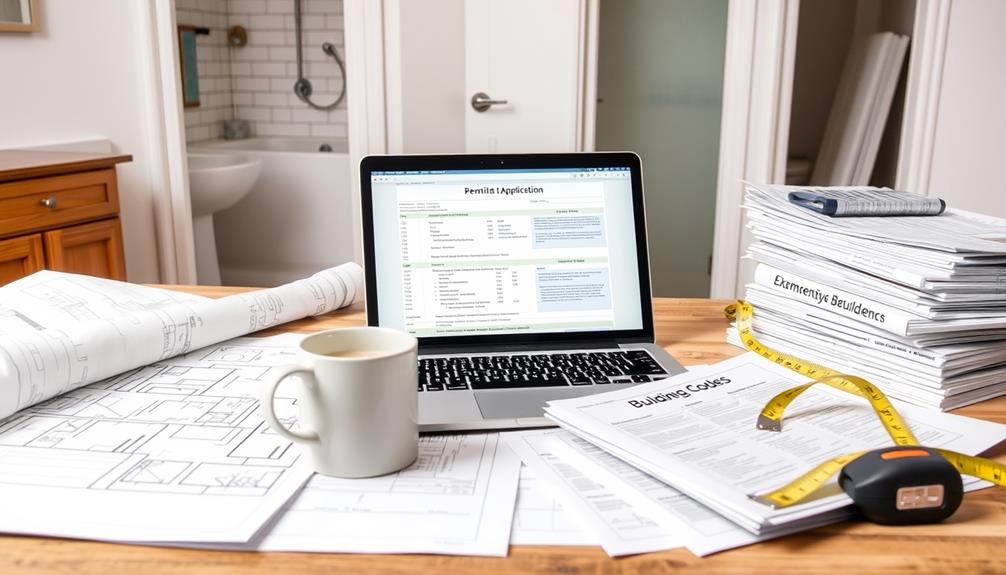
Securing the necessary permits is vital before diving into your bathroom remodel. Start by checking with your local building authorities to identify which permits you'll need for plumbing, electrical, and structural changes. It's best to apply for these permits early in the planning process, as processing times can vary greatly.
| Permit Type | Purpose |
|---|---|
| Plumbing Permit | Guarantees plumbing work meets local codes |
| Electrical Permit | Verifies electrical installations are safe |
| Structural Permit | Confirms compliance with building regulations |
Consult professionals familiar with the permitting process to make certain your work complies with local building codes. Keeping all permit documentation accessible is important, as you'll need it for inspections during and after your remodel. Remember, failing to obtain the necessary permits can lead to fines, delays, or complications when you decide to sell your home down the line. By staying proactive about permits, you'll pave the way for a smoother remodeling experience.
Plan for Demolition
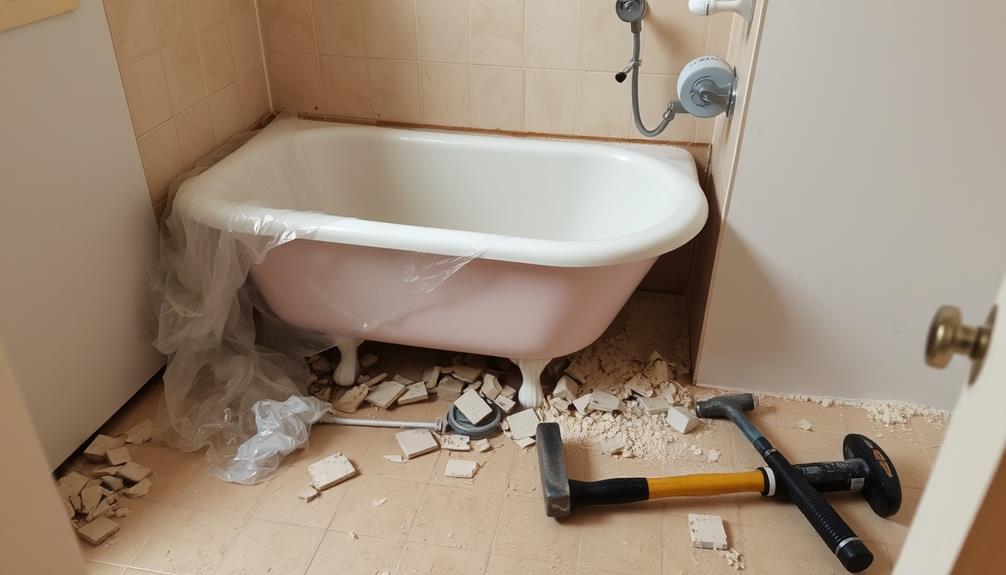
Planning for demolition is a crucial step in your bathroom remodel that sets the stage for a successful renovation. Start by removing all accessories and non-fixed objects to guarantee a clear workspace.
If your project involves plumbing or electrical work, consider consulting with professionals who specialize in mechanic shops for fuel injection cleaning to understand the importance of proper preparations. Next, turn off the electricity at the main breaker box and shut off the water supply. This prevents leaks and electrical hazards during the demolition process.
Protect any fixtures that will remain in the bathroom by covering them to guard against dust and damage. Before you start tearing down walls or removing the toilet, identify load-bearing walls and plug waste pipes to avoid structural issues and plumbing complications.
It's critical to schedule inspections and obtain approvals from local officials before you begin, especially if your project involves plumbing or electrical work. This guarantees compliance with building codes, which can save you from headaches later on.
Install Key Fixtures
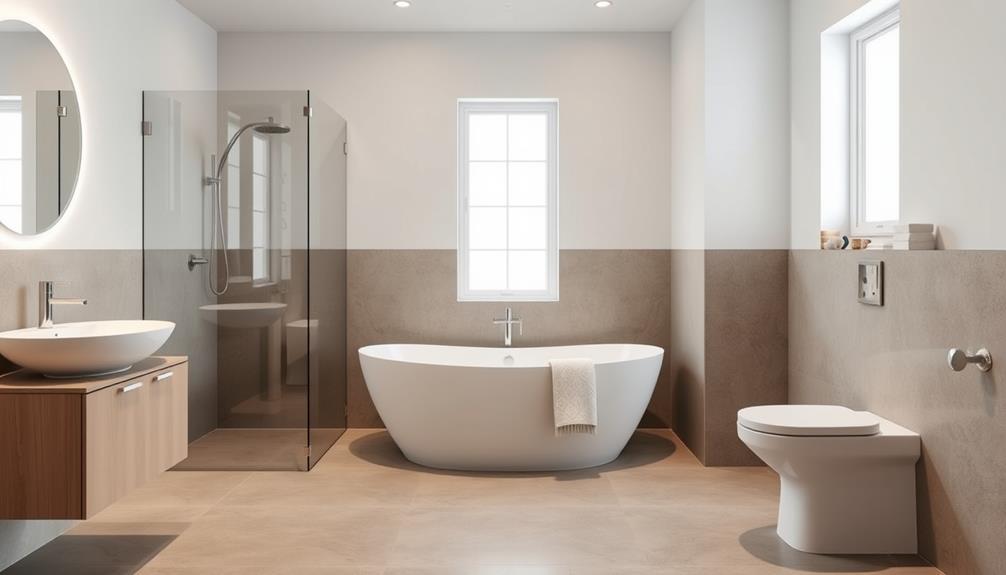
Installing key fixtures is an essential part of your bathroom remodel that can greatly impact both functionality and aesthetics. Start with the toilet, verifying the wax ring creates a watertight seal and that it's level for proper operation. Next, focus on the bathroom vanity. Secure the sink to the vanity and connect the plumbing lines accurately to avoid leaks.
When it comes to the shower, use a PVC waterproof barrier to protect against water damage, and install cement board before tiling for added durability. For the shower controls, verify they're easily accessible and positioned for comfort.
Additionally, lighting fixtures should be installed according to local codes. Remember to place GFCI outlets near water sources for safety. Here's a table to help visualize the key fixtures:
| Fixture Type | Installation Tips |
|---|---|
| Toilet | Level positioning, watertight seal |
| Bathroom Vanity | Align with plumbing, secure sink |
| Shower | PVC barrier, cement board |
| Shower Controls | Accessible positioning |
| Lighting Fixtures | Follow local codes, GFCI outlets nearby |
Select Finishing Touches
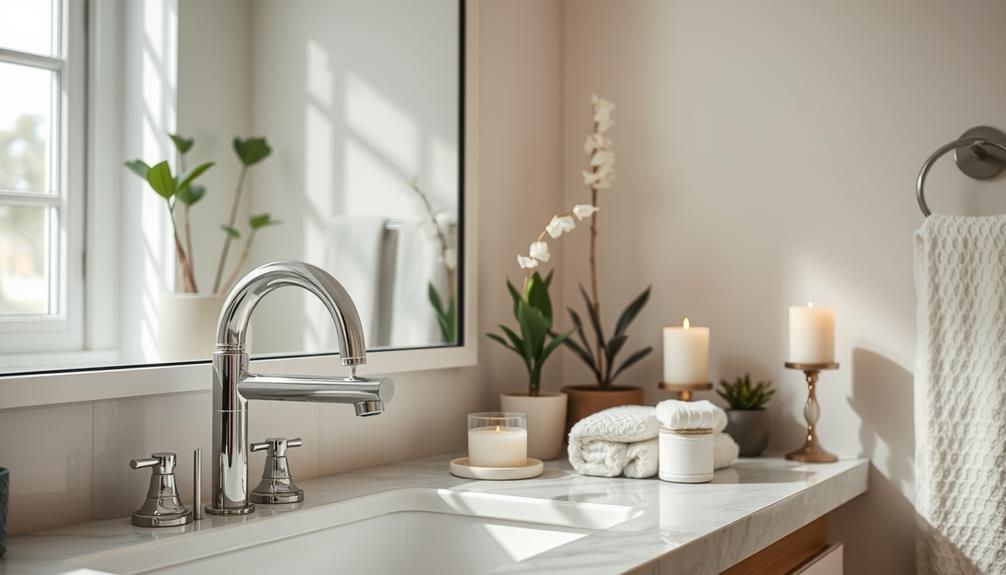
Finishing touches can transform your bathroom from functional to fabulous. When selecting accessories for your bath remodel, aim for pieces that enhance both functionality and aesthetic appeal. Look for soap dishes, trash cans, and other essentials that complement your overall design theme.
Quality towels and bath rugs in moisture-resistant materials not only add comfort but also bring a splash of color or texture to the space. Maximize storage options by incorporating shelving and towel bars that either match or complement your vanity hardware. This creates a cohesive look while improving functionality.
Decorative elements like mirrors and artwork can reflect your personal style and enhance the sense of space and light in the bathroom. Don't underestimate the power of effective lighting—combine decorative fixtures with practical options to guarantee your bathroom is well-lit for ambiance and everyday use.
Frequently Asked Questions
In What Order Should You Renovate a Bathroom?
You should start with planning and obtaining permits, then move to demolition. After that, tackle rough plumbing and electrical work, followed by installing essential features, and finish with tiling, painting, and adding fixtures.
Where Do I Start When Planning a Bathroom Renovation?
Imagine a painter staring at a blank canvas. Start by evaluating your bathroom's layout and pain points. Jot down features you want, set a budget, and gather design inspiration to kick off your renovation journey.
What Is the Most Expensive Part of a Bathroom Remodel?
The most expensive part of a bathroom remodel is usually labor costs. Skilled tradespeople, like plumbers and electricians, charge high hourly rates, and quality materials can considerably increase your overall expenses, often exceeding your initial budget.
Is There an App for Remodeling Your Bathroom?
Yes, there are several apps for remodeling your bathroom. You can use Home Design 3D or Houzz to create 3D models, visualize designs, and even estimate costs, making your renovation process easier and more efficient.
Conclusion
In summary, your bathroom remodel can be a thrilling transformation. By thoughtfully tackling each task, from determining the depth of your design to selecting stunning finishes, you'll create a space that's both functional and fabulous. Remember to balance your budget and beauty, ensuring every aspect aligns with your vision. So immerse yourself in your dream design, and don't hesitate to seek support when needed. With the right planning, you'll achieve a bathroom that's both breathtaking and blissful!
